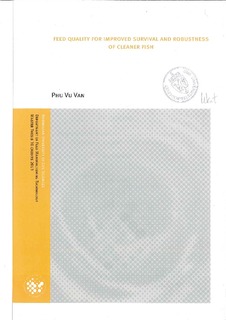| dc.contributor.author | Vu, Van Phu | |
| dc.date.accessioned | 2014-02-19T11:32:20Z | |
| dc.date.available | 2014-02-19T11:32:20Z | |
| dc.date.copyright | 2013 | |
| dc.date.issued | 2014-02-19 | |
| dc.identifier.uri | http://hdl.handle.net/11250/186261 | |
| dc.description.abstract | The aim of study was to improve the quality of moist feed for Ballan wrasse with use of different binders and inclusion level of the binders, as well as optimizing the immersion bath to improve gelling of alginate. Quality of moist feed was evaluated as water stability and texture. Experimental diets were formulated mainly based on a commercial brood stock feed mixed with minced shrimps and a binder. Gelatinized starch was tested at three inclusion levels 10%, 15%, 20%. Gelatin was tested at 2.5%, 5% and 7.5% inclusion level. Sodium alginate was tested at 1.5% and 3% level in the diet. The gelling of alginate was tested with use of 2% and 4% CaCO3 and with immersion of pellets in two solutions, either CaCl2 5% or a mix of CaCl2 3% + formic acid 3%. The alginate pellets were also produced with or without CaCO3 added in the dough, followed by immersion in a solution of CaCl2 5% or mix of CaCl2 3% + formic acid 3%. A combination of all three binders was also tested in different immersion solutions.
The results showed that water stability was not affected by binder type or inclusion level. Among the pellets with sodium alginate, alginate level and CaCO3 level did not improve water stability. Improved water stability was found for pellets immersed in CaCl2 5% compared to a mix of CaCl2 3% + formic acid 3%.
The pellet texture was affected by binder type and inclusion level. Gelatinized potato starch gave highest texture, followed by alginate and gelatin. Texture was significant improved with increasing binder level. Texture on moist feed produced with alginate was also improved with use of CaCO3 in the dough. Recommended inclusion level is 2%. Immersing alginate pellets in a mix of CaCl2 3% + formic acid 3% improved texture compared to CaCl2 5% .The overall conclusion from the experiment was that water stability was unaffected or even impaired by immersing pellets in formic acid or CaCl2. Texture of the pellet was easier to manipulate by the inclusion level of binder and immersion solution. | no_NO |
| dc.description.sponsorship | Norwegian University of Life Science | no_NO |
| dc.language.iso | eng | no_NO |
| dc.publisher | Norwegian University of Life Sciences, Ås | |
| dc.subject | Moist feed | no_NO |
| dc.subject | Ballan wrrasse | no_NO |
| dc.subject | binders | no_NO |
| dc.subject | Water Stability | no_NO |
| dc.subject | Pellet Texture | no_NO |
| dc.title | Feed quaility for improved survival and robustness of cleaner fish | no_NO |
| dc.type | Master thesis | no_NO |
| dc.subject.nsi | VDP::Agriculture and fishery disciplines: 900::Fisheries science: 920::Aquaculture: 922 | no_NO |
| dc.source.pagenumber | 32 | no_NO |
